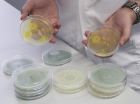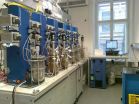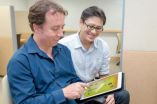(Press-News.org) This news release is available in German.
Erythritol has many great advantages: it does not make you fat, it does not cause tooth decay, it has no effect on the blood sugar and, unlike other sweeteners, it does not have a laxative effect. In Asia it is already widely used and it is becoming more and more common in other parts of the world too. Up until now, erythritol could only be produced with the help of special kinds of yeast in highly concentrated molasses. At the TU Vienna, a method has now been developed to produce the sweetener from ordinary straw with the help of a mould fungus. The experiments have been a big success, and now the procedure will be optimized for industry.
From Straw via Sugar to Erythritol
Straw is often considered to be worthless and is therfore burnt, but it can be a precious resource. Some of its chemical components can be made into valuable products. First, the finely chopped straw has to be "opened up": with the help of solvents, the cell walls are broken, the lignin is dissolved away. The remaining xylan and cellulose are then processed further.
"Usually the straw has to be treated with expensive enzymes to break it down into sugar", says Professor Robert Mach (Vienna University of Technology). "In highly concentrated molasses, special strains of yeast can then turn the sugar into erythritol, if they are placed under extreme osmotic stress."
Mould Fungus Makes Intermediate Step Obsolete
The enzymes opening up the straw can be obtained with the help of the mould fungus Trichoderma reesei. This kind of mould also plays the leading role in the new production process developed at the Vienna University of Technology.
Two big advantages have been achieved by genetically modifying the fungus: the process of obtaining the enzymes from mould cultures and chemically cleaning them used to be cumbersome – now the improved strain can be directly applied to the straw. Secondly, the mould can now produce erythritol directly from the straw. The intermediate step of producing molasses is not necessary any more and no yeast has to be used.
"We knew that the mould fungus Trichoderma reesei is in principle capable of producing erythritol, but usually only in tiny quantities", says Robert Mach. "By genetically modifying it, we managed to stimulate the production of an enzyme, which enables the large-scale production of the sweetener."
Erythritol is about 70 to 80 percent as sweet as sugar. Today, 23000 tons of erythritol are produced every year. This quantity could increase considerably if the trend of switching to erythritol spreads from Asia to Europe and the US. Astrid Mach-Aigner and Robert Mach from the Vienna University of Technology have already patented the new production process, together with the company ANNIKKI. "We have proven that the new production method works", says Robert Mach. "Now we want to improve it together with our industry partners so that it can be used for large-scale production."
INFORMATION:
Original publication: http://www.amb-express.com/content/4/1/34
Further Information:
Dr. Astrid Mach-Aigner
Institute of Chemical Engineering
Vienna University of Technology
Gumpendorfer Straße 1a, 1040 Vienna
T: +43 (1) 58801 - 166 558
astrid.mach-aigner@tuwien.ac.at
Prof. Robert Mach
Institute of Chemical Engineering
Vienna University of Technology
Gumpendorfer Straße 1a, 1040 Vienna
T: +43 (1) 58801 - 166 502
robert.mach@tuwien.ac.at
Sweet sweet straw
Ordinary straw can be converted into the sweetener erythritol by genetically modified mould fungi
2014-06-24
ELSE PRESS RELEASES FROM THIS DATE:
Expert outlines challenges of visual accessibility for people with low vision
2014-06-24
June 24, 2014 – New approaches and tools are needed to improve visual accessibility for people with low vision in the "real world," according to a special article in the July issue of Optometry and Vision Science, official journal of the American Academy of Optometry. The journal is published by Lippincott Williams & Wilkins, a part of Wolters Kluwer Health.
Vision science, in collaboration with other professions, has a key role in developing technologies and design approaches to promote visual accessibility for the millions of people living with low vision, according ...
Experts cite 'misconceptions' on brain metastases
2014-06-24
June 24, 2014 – "Key historical misconceptions" are hindering progress in research and treatment for patients with cancer metastases to the brain, suggests a special article in the July issue of Neurosurgery, official journal of the Congress of Neurological Surgeons. The journal is published by Lippincott Williams & Wilkins, a part of Wolters Kluwer Health.
Dr. Douglas Kondziolka of NYU Langone Medical Center and coauthors identify some issues that may be standing in the way of optimal clinical management for patients with cancer that has spread to the brain from other ...
New transdermal SARM drug for muscle-wasting offers hope for older cancer patients
2014-06-24
CHICAGO, IL—Muscle wasting that occurs as a result of cancer negatively impacts the well-being and recovery prospects of millions of patients, particularly the rapidly-growing elderly populations in Western societies. Drugs called selective androgen receptor modulators (SARMs) offer hope for these patients, and a new SARM for transdermal administration is promising excellent efficacy without harming liver function and HDL levels. Results and conclusions were presented Tuesday at the joint meeting of the International Society of Endocrinology and the Endocrine Society: ICE/ENDO ...
Gender differences could mean more risk for cardiovascular death
2014-06-24
Queen's University assistant professor Pendar Farahani (Department of Medicine and Department of Public Health Sciences) is advocating the use of gender-based treatment for mitigating the cardiovascular risk factors related to diabetes.
Research has shown women with Type 2 diabetes and high cholesterol are less likely than their male peers to reach treatment goals to lower their bad cholesterol, or low-density lipoprotein (LDL) cholesterol.
"The findings suggest the need for gender-based evaluation and treatment of cardiovascular risk factors in these patients," says ...
Study finds high CD4 cell counts associated with reduced risk of ischemic stroke for those with HIV
2014-06-24
OAKLAND, Calif., June 24, 2014 — A 15-year study found that HIV-positive individuals had a 40 percent increased risk of ischemic stroke, however stroke rates were nearly the same for HIV-positive individuals with high CD4 cell counts as for HIV-negative subjects.
The study, published recently in AIDS, the official journal of the International AIDS Society, covered the years 1996 through 2011 and included nearly 25,000 HIV-positive individuals.
Ischemic stroke is caused by plaque build-up in blood vessels, which can lead to constriction or actual obstruction of blood ...
Bizarre parasite from the Jurassic
2014-06-24
Around 165 million years ago, a spectacular parasite was at home in the freshwater lakes of present-day Inner Mongolia (China): A fly larva with a thorax formed entirely like a sucking plate. With it, the animal could adhere to salamanders and suck their blood with its mouthparts formed like a sting. To date no insect is known that is equipped with a similar specialised design. The international scientific team is now presenting its findings in the journal "eLIFE".
The parasite, an elongate fly larva around two centimeters long, had undergone extreme changes over the ...
Aging accelerates genomic changes, signaling challenges for personalized medicine
2014-06-24
Exploiting individual genomes for personalized medicine may be more complicated than medical scientists have suspected, researchers at the Virginia Bioinformatics Institute of Virginia Tech have discovered.
In a paper published in June in the journal Aging, scientists from the institute's Medical Informatics and Systems Division found that spontaneous mutations occur in our bodies constantly, but the rate of change differed dramatically among various people.
The study has implications for personalized medicine, which will make use of genomic information to predict future ...
Young women with PCOS are 5 times more likely to develop type 2 diabetes
2014-06-24
A leading expert on reproductive health says young women with Polycystic Ovary Syndrome (PCOS) have a startlingly higher risk of developing type 2 diabetes, even if young and not overweight.
The research led by Professor Helena Teede and Dr Anju Joham, from the School of Public Health and Preventive Medicine at Monash University analysed a large-scale epidemiological study, called the Australian Longitudinal Study of Women's Health, which revealed the findings.
Over 6000 women aged between 25-28 years were monitored for nine years, including 500 with diagnosed PCOS. ...
New possibilities for leukemia therapy with a novel mode of leukemia cell recognition
2014-06-24
Singapore, 24 June 2014—Scientists at A*STAR's Singapore Immunology Network (SIgN) have discovered a new class of lipids in the leukaemia cells that are detected by a unique group of immune cells. By recognising the lipids, the immune cells stimulate an immune response to destroy the leukaemia cells and suppress their growth. The newly identified mode of cancer cell recognition by the immune system opens up new possibilities for leukaemia immunotherapy .
Leukaemia is characterized by the accumulation of cancer cells originating from blood cells, in the blood or bone marrow. ...
NTU study shows puzzle games can improve mental flexibility
2014-06-24
Want to improve your mental finesse? Playing a puzzle game like Cut the Rope could just be the thing you need.
A recent study by Nanyang Technological University (NTU) scientists showed that adults who played the physics-based puzzle video game Cut the Rope regularly, for as little as an hour a day, had improved executive functions.
The executive functions in your brain are important for making decisions in everyday life when you have to deal with sudden changes in your environment – better known as thinking on your feet. An example would be when the traffic light ...
LAST 30 PRESS RELEASES:
Making lighter work of calculating fluid and heat flow
Normalizing blood sugar can halve heart attack risk
Lowering blood sugar cuts heart attack risk in people with prediabetes
Study links genetic variants to risk of blinding eye disease in premature infants
Non-opioid ‘pain sponge’ therapy halts cartilage degeneration and relieves chronic pain
AI can pick up cultural values by mimicking how kids learn
China’s ecological redlines offer fast track to 30 x 30 global conservation goal
Invisible indoor threats: emerging household contaminants and their growing risks to human health
Adding antibody treatment to chemo boosts outcomes for children with rare cancer
Germline pathogenic variants among women without a history of breast cancer
Tanning beds triple melanoma risk, potentially causing broad DNA damage
Unique bond identified as key to viral infection speed
Indoor tanning makes youthful skin much older on a genetic level
Mouse model sheds new light on the causes and potential solutions to human GI problems linked to muscular dystrophy
The Journal of Nuclear Medicine ahead-of-print tip sheet: December 12, 2025
Smarter tools for peering into the microscopic world
Applications open for funding to conduct research in the Kinsey Institute archives
Global measure underestimates the severity of food insecurity
Child survivors of critical illness are missing out on timely follow up care
Risk-based vs annual breast cancer screening / the WISDOM randomized clinical trial
University of Toronto launches Electric Vehicle Innovation Ontario to accelerate advanced EV technologies and build Canada’s innovation advantage
Early relapse predicts poor outcomes in aggressive blood cancer
American College of Lifestyle Medicine applauds two CMS models aligned with lifestyle medicine practice and reimbursement
Clinical trial finds cannabis use not a barrier to quitting nicotine vaping
Supplemental nutrition assistance program policies and food insecurity
Switching immune cells to “night mode” could limit damage after a heart attack, study suggests
URI-based Global RIghts Project report spotlights continued troubling trends in worldwide inhumane treatment
Neutrophils are less aggressive at night, explaining why nighttime heart attacks cause less damage than daytime events
Menopausal hormone therapy may not pose breast cancer risk for women with BRCA mutations
Mobile health tool may improve quality of life for adolescent and young adult breast cancer survivors
[Press-News.org] Sweet sweet strawOrdinary straw can be converted into the sweetener erythritol by genetically modified mould fungi




